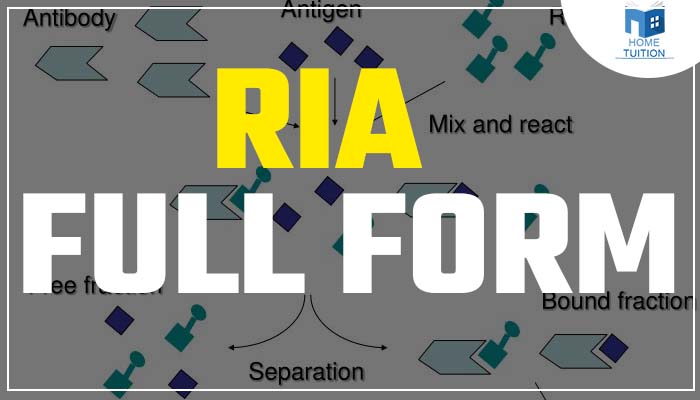RIA Full form
The full form of The radioimmunological assay.
Full form of RIA
The full form of RIA is "The radioimmunological assay" is focused on the principle of all immunological assays, which is the recognition of an antigen present in a sample by antibodies directed against that antigen. The principle of the radioimmunological assay is very similar to competitive ELISA, and it quantifies small molecules, peptides, and proteins in biological samples.
This article will discuss the main elements like the Definition of RIA, RIA Full-Form Principles, Types & Roles OF RIA in Life Science. So read the full article carefully to know more.

Definition of RIA
The radioimmunoassay technique (RIA) is very sensitive in vitro technique used to measure the concentration of antigens (e.g., hormone levels in the blood) through these antibodies. Radioimmunoassay (RIA) is focused on the principle of all immunological tests, which is the recognition of an antigen that is present in a sample by antibodies targeting this antibody. The principle of radioimmunoassays is very similar to competitive ELISA and enables the quantification of small molecules, and small intestinal cells.
Principles and Techniques of RIA
RIA is performed using antibody-antigen binding and radioactive antigen. The basic principle of RIA is a competitive binding reaction, where an analyte (for example, an antigen) competes with a radiolabeled antigen for binding to a fixed antibody or receptor binding sites. The binding of the unlabeled antigen to a fixed and limited amount of antibody causes displacement of the radiolabeled antigen. It leads to a decrease in the radioactivity of the antigen-antibody complex.
- A radiolabeled antigen (e.g., I125-labeled insulin) is prepared to compete with the unstable antigen for the limited number of binding sites of the specific antibody raised against insulin.
- The antigen binds to the antibody. Due to inadequate binding sites, some antigens will be free and include radiolabeled antigens.
- After equilibrium is established, the antigen-antibody complex is regenerated using appropriate reagents. The supernatant is separated from ?re?i?it?te by centrifugation.
- The supernatant is separated from the precipitate by centrifugation.
- The precipitate (bound antigen, B-form) and the supernatant (free antigen, F) will have radioactivity because they have I125 – insulin.
- These two forms' radioactivity range is measured on gamma-well type scintillation counters.
- The free form's radioactivity may be related to the concentration of the unlabeled antigen.
- Alternatively, the sound form radiosity or B/F ratio is also related to the concentration of the unlabeled antigen.
- Different concentrations of unlabeled insulin standards are used separately with the same concentration of labelled insulin.
- The assay is very sensitive because the tags used for RIA have high specific activity.
- Normally, an antibody is raised for whatever antigen is to be assessed. This technique is referred to as radioimmunoassay because it combines radioactivity and immune function (antigen binding to antibody).
Types of RIA
Two RI? methods are commonly used for drug detection in biological matrices: double antibody RI? and encapsulated tube.
-
Dual Antibody RIA: In a dual antibody RIA, a second antibody is added to facilitate precipitation of the bound primary antibody. Once the primary/secondary antibody-antigen complex is precipitated, the unbound labelled drug can be easily removed.
-
Coated tube RIA: In coated tube RIA, the primary antibody is coated on the inside of each tube. Unbound labelled drugs can quickly be removed by decanting the supernatant.